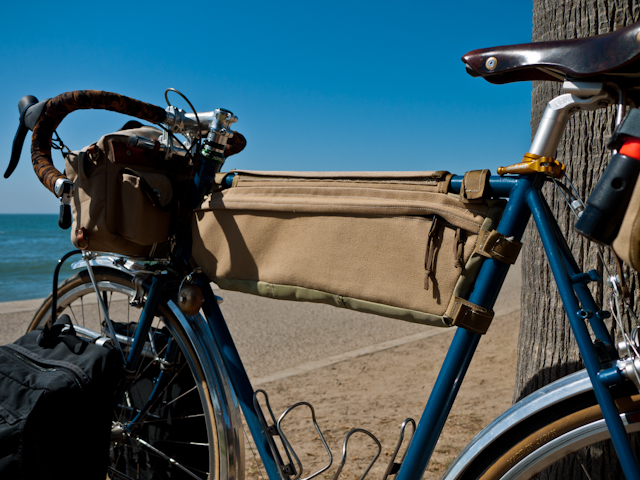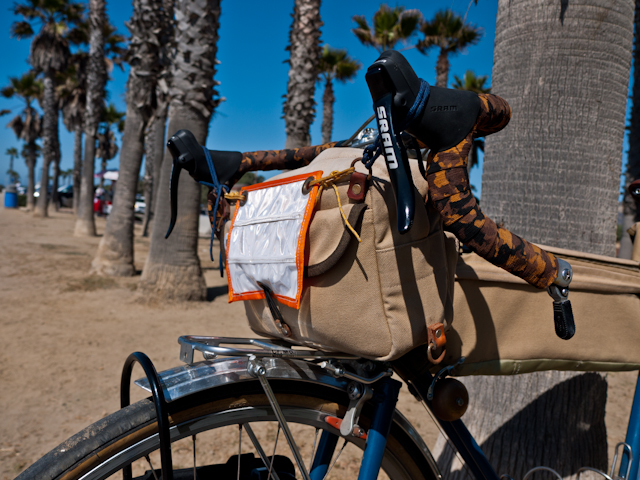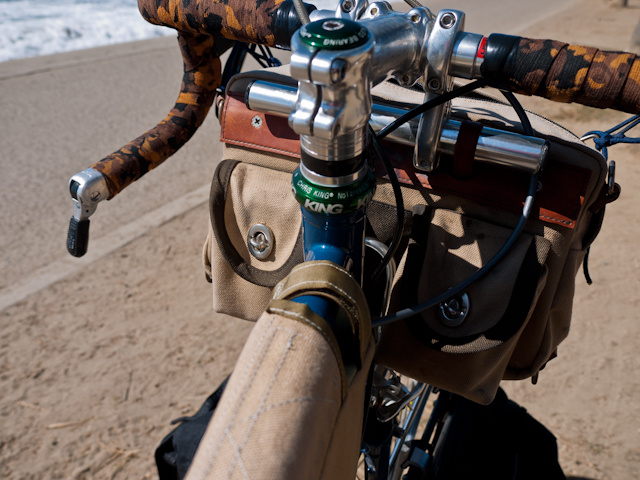Lately I have been getting more interest in the various bags I have on my Rambler. The 5 bag set up I have been running in most of the pictures is a mash-up of self-made and store-bought bags that have built up over the last five years. Some are on the bike every day, while others, the panniers, are only there for the more voluminous loads. I have a few new designs I am getting ready to sew up, and before the switch I thought it would be a good time to share my thoughts on each of the bags.
Up front I have been using an Acorn brand handle bar bag for a few years now. These bags are hand-made by a husband and wife team in Los Angeles, and are an incredible value if you can get your hands on one.
This bag holds all of my essentials: spare tube, patch kit, pump (Lezyne micro floor drive) multi tool, maps, energy bar for an emergency bonk and plenty of room left over for my Micro 4/3 camera kit or a lunch and jacket etc. The bag is made with un-waxed canvas, and has proven water tight through a few rainy seasons now. You will also not my “FrontFlector” No.1. I have a couple of different versions, all working as hoped. While not a headlight replacement, I have found it quite effective in getting driver’s attention. There is over a full 20 square inches of 3m reflective tape, it can easily be retro fit to most traditional front bags, and is integral with the front pocket. I will be offering these as part of the line over this winter.
The frame bag I run all the time is the first one I have ever made. It came out well enough in spite of my early sewing skills and has help up far better than I expected.

Some of the design aspects were meant to be a trial, assuming I would need to replace or repair in time. It is going on two years at this point, and nothing has needed anything other than use. I carry my pole mounted GoPro camera in it on most rides, and often use it to carry a dozen eggs. On longer rides it holds a 2l platypus bladder, and in the winter it holds my extra layers and the come on and off throughout the ride. Like the Acorn bags, I chose the un-waxed canvas, and it had proven water tight through two winters.
On the rear I have my self-made saddle bag.

I originally made this bag to increase the rear loading capacity of my Rivendell Roadeo, a sport bike, that was not intended to carry panniers, but has a geometry biased towards rear load. It has just a bit more room than a Carradice Nelson long flap. Made with the same un-waxed canvas, it has yet to let me down in a California rain storm. As of late it mostly holds up the reflector, and the occasional bulky package.
It also, like my front bag, has a self-made reflector. Starting with the basic premise of the reflective triangles made for runners, I upped the reflective surface area. Most triangles have a mesh center, but if you are strapping it to you bike or bag, a breathable center is a waste of real estate IMO. It may look a bit dorky, but after thousands of miles at the margins of the day, it gets results. Hands down cars give me a wider passing space when it is on there, and I do not leave home without it on the bike.
For the loads with a bit more volume I have a set of the Jandd Mini MTN panniers, that I modified with a set of Arkel mounting hooks. These have been with me for well over 5 years now and have proven quite versatile.
They are a mass-produced bag, made with Cordura Nylon. They are fairly water-resistant, but have had leakage in heavy rain. The width of the bottom half is expandable for the really big loads. I have used these for everything from touring, to groceries and commuting. They will swallow a gallon of mill, 2 quarts of yogurt and have tons of room the softer packages. While labeled mini, these have a surprising amount of capacity and are rated at 2000 ci for the pair.
I am pretty happy with all these bags. If it were not for the constant need to tinker, the tools and ability to make exactly what I want, and it being part of the business, I would probably push these bags for a decade or more. So what is next? I am planning on making a 5 bag set with Dimension Polyant’s XPAC laminate material. This is a composite 3 layer laminate of cordura, mylar, and pack cloth with rip stop fibers. The weight is a fraction of the canvas, and it will be waterproof. Canvas is great, but my three every day bags tip the scales at around 7 lbs empty, that is significant IMO. I will still have a set of canvas bags in the works, bit materials have pros and cons, and I need to work it out with some test bags.
The rambler is designed to handle modest front loads, and I want to up the size on the handlebar bag. This will reduce my tendency to fall back on the panniers when I need just that little bit more space. The design will be rooted in a traditional Berthoud style bag, but with modern materials and a couple of twists.
The frame bag will be similar in design to my current bag, but with a couple of improvements and the use of XPAC as the main material.
The saddle bag will shrink a bit, have a different closure system, and shape.
Fourth on the lest is a set of roll top panniers. Everything I can find on the market, short of the Berthoud mini, is still a bit big for most of what I need. I am leaning towards a roll top design for water tightness and a bit of flexibility in volume. I will use Arkel hooks until I can find something lighter that is as easy to get on and off, yet incredibly secure.
Time to move the designs from paper to pattern, cut some cloth and get sewing.



I can get you some used sailboat sails if you want to use that as your testing material for your bags. I can bring it to the SF Bike Expo if you can wait until then.
Let me know if you need any help Rob. Excited to see what you come up with.
“The design will be rooted in a traditional Berthoud style bag, but with modern materials and a couple of twists.” Looking forward to what you come up with on this front. I recently made a bag/box with just coroplast and was surprised that it wasn’t much lighter than a Berthoud (~600g for the large, I think). Doesn’t mean there isn’t room for improvement in other areas, though!
Dear Rob,
I assume you’ve seen the GB-25N (nylon) bike bag pattern I bodged together and posted a few years ago on the Randon list. I believe
http://ifihadabikeblog.blogspot.com/2010/10/diy-handlebar-bag.html
still hosts the patterns and (my poor) instructions. Feel free to use and modify as you wish.
Best Regards,
Will
William M. deRosset
Fort Collins, CO
William, I have the pattern and even printed it up a few copies and cut one out, thank you for putting it together. I just need to actually cut one from cloth and stitch it up. your pattern is well done and a great starting place. At this point I am wishing I could clone a copy of myself, time is the tightest commodity.